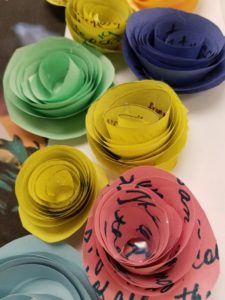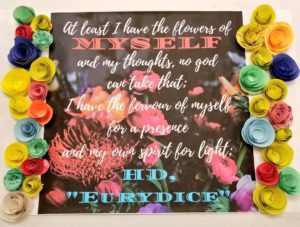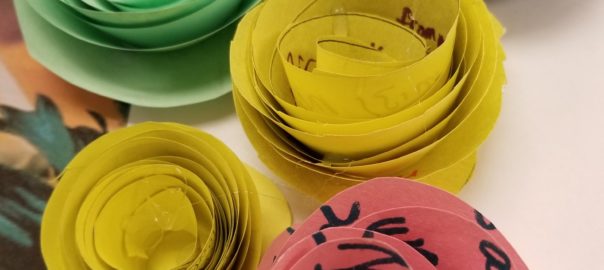 Last week in English 10 we did an experimental project that turned out really neat, so I’m going to brag about it here!
Last week in English 10 we did an experimental project that turned out really neat, so I’m going to brag about it here!
We’ve been reading selections from Ovid’s Metamorphoses using some lesson plans from EDSITEment! to build from. For this plan, we compared and contrasted three versions of the Orpheus & Eurydice myth: one from NewsELA, A. S. Kline’s translation of Ovid’s version, and the poem “Eurydice” by H.D. At first I wasn’t very excited about HD’s, but as often happens when I analyze a piece of modern poetry, I started to like it more and more each time I read it, and by the time I taught it to the students, I was envisioning a really cool art project to engage them in the poem.
“Eurydice,” unlike the other two versions, is told in first person from Eurydice’s point of view. Through the sections of the poem, Eurydice moves from anger at Orpheus:
so for your arrogance
and your ruthlessness
I am swept back…
I am broken at last
to despair:
all the flowers that cut through the earth,
all, all the flowers are lost;
everything is lost,
everything is crossed with black,
black upon black
and worse than black,
this colourless light.
to empathy and acceptance:
my hell is no worse than yours
though you pass among the flowers and speak
with the spirits above earth.
to a sort of strength and hope:
At least I have the flowers of myself,
and my thoughts, no god
can take that;
I have the fervour of myself for a presence
and my own spirit for light;
and my spirit with its loss
knows this;
though small against the black,
small against the formless rocks,
hell must break before I am lost;
before I am lost,
hell must open like a red rose
for the dead to pass.
(I really wanted to make all of that into the poster image, but space constraints meant I focused on the first part.)
I talked with the students about the flower motif throughout the poem, the juxtaposition of the colors of flowers with “this colourless light” in Hades, and we talked about what it meant that at the end, she was no longer sad, even though she would never see flowers or be alive again.
Eventually, after a kid in my advisory helped me experiment for quite a while with templates and brought in a glue gun, we worked with the class to make this:
It’s a big poster of the image I made in
Canva, kindly printed for us by the school secretary with a border on either side; then, the students
made spiral roses out of paper. Earlier in the week I had asked them to write down memories and thoughts that encouraged them in tough times in their writer’s notebooks. On paper flower day, they chose a thought or memory to write out on the paper, then cut the spiral. (I had some pre-drawn spirals copied onto yellow paper for the students who wanted a guideline–so you can see many of them took me up on that! The other colors are freehand roses, which is why their size varies so much.)

Once they cut the roses I hot-glued them (and my fingers, yeowch!) and gave students the option of making extra roses for themselves (the art teacher offered us some magnets, so they could make locker bouquets–and two of the kids glued roses to cardstock to give as gifts to people who had helped them in hard times! Not my idea–the kids both came up with that independently).
I was pleasantly surprised by how seriously the students seemed to take this (it didn’t hurt that it happened to be right after the school’s Veterans Day assembly, so they were already in a more serious mood than usual) but most of the students worked very diligently on writing memories and thoughts onto their paper, and then rolling up their roses. Some of them hit snags–cardstock is too thick unless you get rough with it; construction paper tends to rip if the spiral is too thin–but we ended up with a really lovely bunch of flowers to display!
I’m very pleased with this project and will definitely do it again next year. Hopefully the students will also take comfort from seeing their roses on display in the classroom, or in their lockers or wherever else!
 Last week in English 10 we did an experimental project that turned out really neat, so I’m going to brag about it here!
Last week in English 10 we did an experimental project that turned out really neat, so I’m going to brag about it here!

